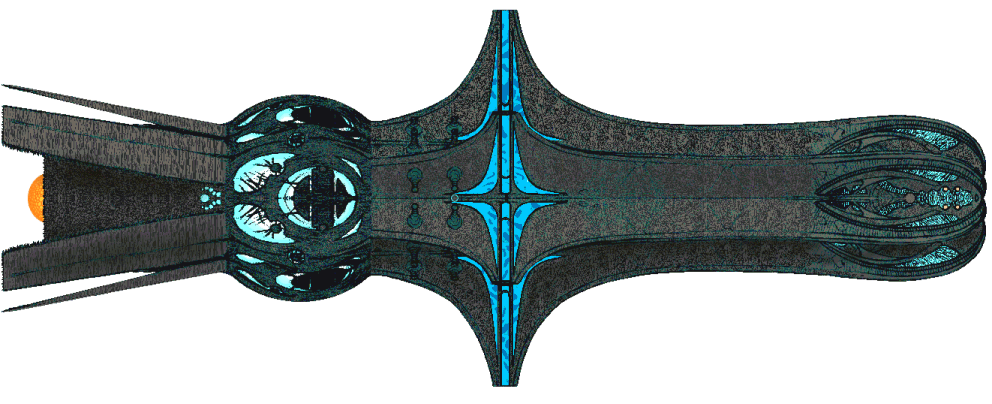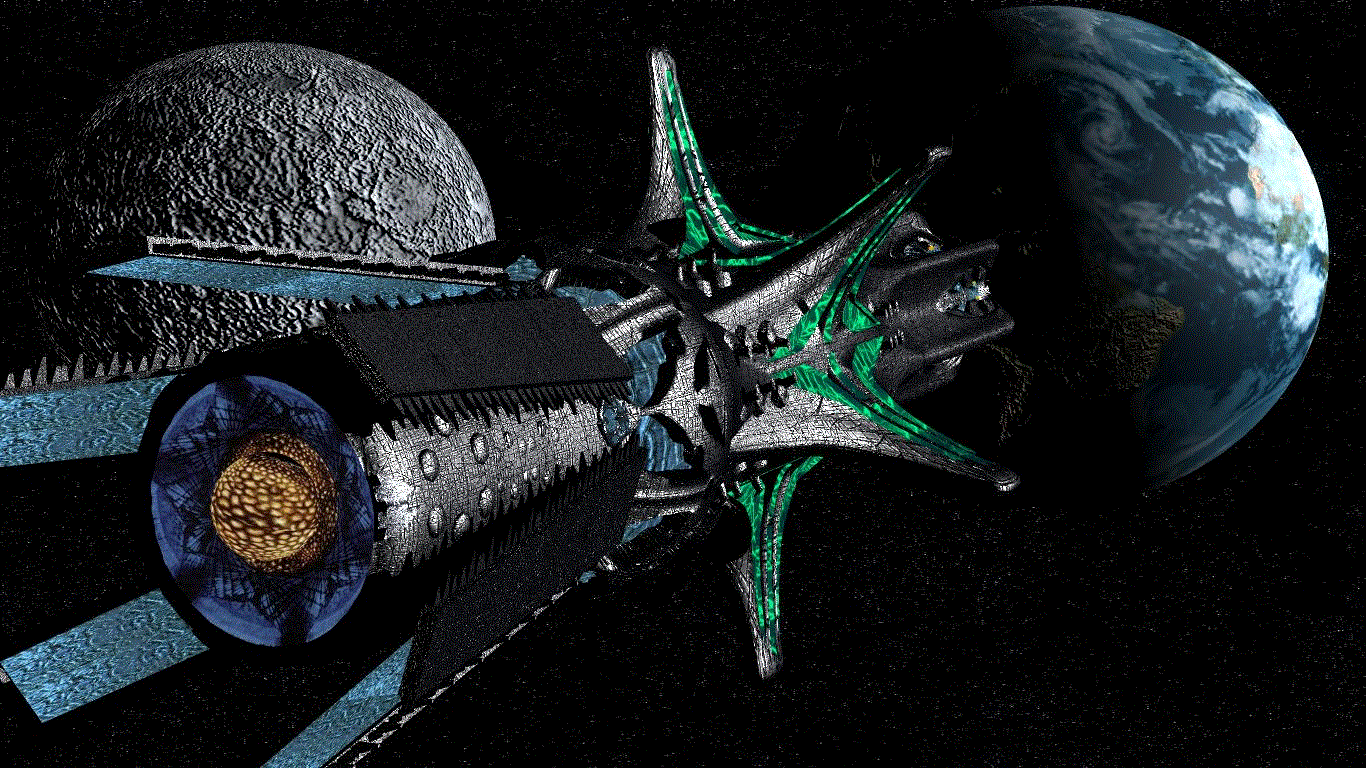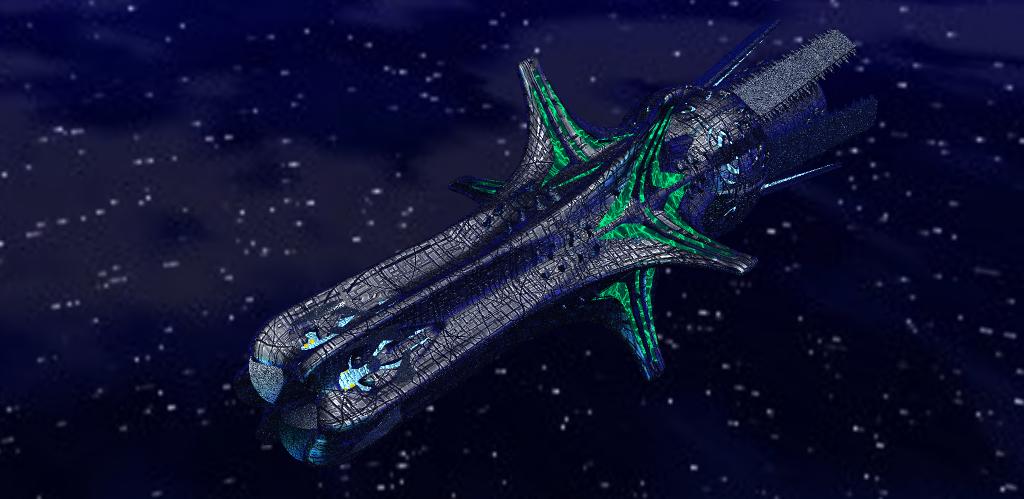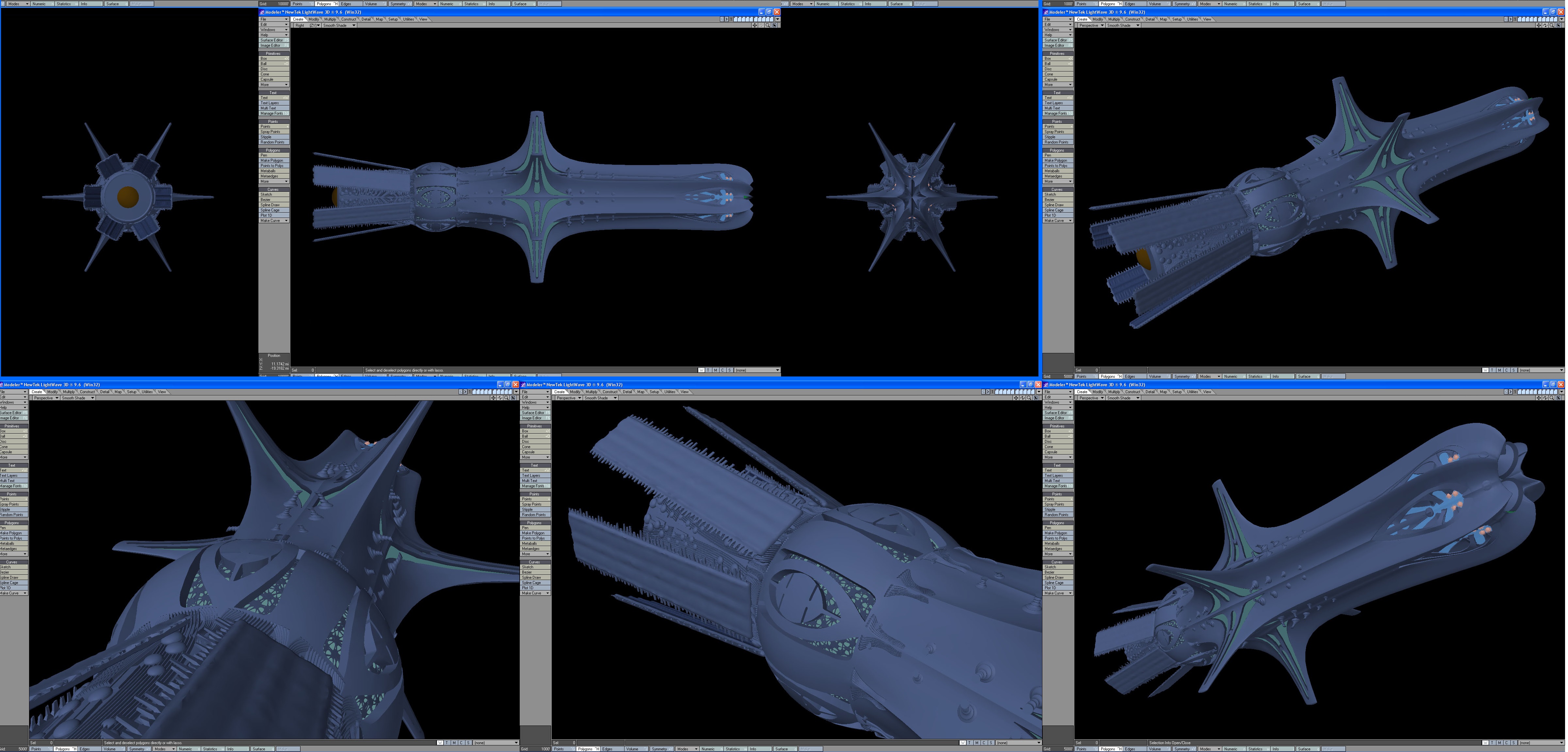
United Galaxies Council. | MULE-Class
Fleet Tug (ATF). | 
United Galaxies Council. |
|---|
The MULE-Class Fleet Tug was the last of the Landships to be designed. Unlike the other Landships, the MULE-Class was created out of a need; The FOLKER-Class UES KAY  | | MULE-Class Fleet Tug, Starboard Line Drawing. |
|---|
 | | MULE-Class, Astern Aspect. |
|---|
 | | MULE-Class, Abow Aspect. |
|---|
 | | MULE-Class Engineering Drawings. |
|---|
JONES assigned to Luna Garrison became disabled after an accident on board (details of which remain classified to this day). No platform for this kind of problem actually existed at that time, so UES HENRY FORD, UES JAY AUSTIN (both EMIL LANG-Class), and UES JOHN PERSHING (a FOLKER-Class) rushed to the scene; The FORD and AUSTIN would lift the JONES up, while the PERSHING pushed her to Luna-994 (the nearest place where she could be berthed). The recovery effort was a technical success, but revealed PAINFULLY the critical need for a fleet tug. Thus MULE-Class was born.UES MULE was randomly selected as the testbed and R&D platform; She was outfitted a dozen electromagnetic grapples (modified versions of the more normal anchor cables), several additional grav pods, and a tractioning drive FAR more powerful than anything such a small ship (boat, really) would ever need, then her weather deck covered in a simple plastic dome. During her feild test a few days latter, she lifted UES KAZZIANA HESH-TULL (a HAYES-Class) with UES ZUNI (a FOLKER-Class) on her deck; Proof positive of the concept. UES MULE went back to the yards for a few minor cosmetic changes, consisting of a "blockhead" bow crumple zone and globular mid-ship section. After 50 years of this configuration, a totally new, highly distinctive MULE-Class hull First appeared, selected due to its aesthetic (too many complaints about "the ugly boxes" from too many quarters finally got the UWA to act).UES MULE was not at that point armed, and the lasers in fact weren't added until a few years later after an Atorian Malcont raid on Terra itself, with the aim being to destroy the MULES (the idea being then the Terrans couldn't launch some defenses). After that, all MULES were sent IMMEDIATELY to the yards and be upgraded.Powerplant:The MULE-Class are powered primarily by twin SRO-18db reflex furnaces, with an auxiliary HtmR 731 dual phase hydrocell scramjet.SRO-18db Reflex Furnace:The SRO-18bd produces a combined 25,000 KWh at 500,000 hsp. This is enough that a MULE-Class can push/tow a BREETIA TULL-Class at about Mach 1 (this is not theoretical; they actually do that all the time, with 2-5 additional ships providing course correction, but not otherwise influencing the movement).HtmR 731 Dual Phase Hydrocell Scramjet:The HtmR 731 Dual Phase Hydrocell Scramjet produces 14,000 KWh at 325,000 hsp. The scramjet is mounted centerline (in fact, it's inside of the keel beam), and "can" produce enough power itself to tow/push most ships in the UGC's fleet, though more often multiple MULE'S are used.Thrust:The MULE-Class are propelled primarily by triple 45/43gdX Tractioning Drives producing a combined 25,000 KWh at 500,000 hsp, with an auxiliary HtmR 731 dual phase hydrocell scramjet producing 14,000 KWh at 325,000 hsp.45/43gdX Tractioning Drives:The triple 45/43gdX Tractioning Drives producing a combined 25,000 KWh at 500,000 hsp, enough to effectively move even the largest ships; Only full-fledged space stations are too big for a single MULE to move, and even at this, once 2-5 have gotten one moving, one can keep it moving and (with planning) provide braking power as well.HtmR 731 Dual Phase Hydrocell Scramjet:The auxiliary HtmR 731 dual phase hydrocell scramjet produces 14,000 KWh at 325,000 hsp. This is not typically enough to move capital ships, but only a few of the largest ships require more than 3 tugs.Flight System:For most purposes, the MULE-Class is restricted to grav pods for light; However, a yearly drill by each ship of this class using the ship's relatively wide body as a massive air brake allowing it to "more or less" safely enter an atmosphere for a hard landing1, during which the HtmR 731 is powered up to return to orbit; Due to the probability for massive impact damage, the ships aren't actually allowed to land but rather conduct 3 "touch and go" drills, powering out of the crash at 100 feet and returning to orbit.Employment:Each UGC battle fleet has 1 MULE for every 10 other ships (less the CAPRICA-Class Fuelers/KC-200 Refuelers). This makes them abundant and thus likely to attract fire, necessitating the weapons upgrade they eventually received.In the civilian sector, every UGC-sponsored anchorage or port except the Babylon-Class Stations has at least a couple, many have much more (the Babylon-Class have their own classes of ships, which the UGC wants to keep separate). They are generally indispensable in this role, though many ports have smaller tugs for more general use.Weapons Systems:Sadly, even the MULE-Class have to be armed; That's a reality of the UGC.The first ship was not armed at all; She was intended to be a tug ship, and thus weapons "shouldn't" have been needed. After Atorians began targeting MULE'S simply to vex Robbies and cost the IPA money, the fleet was recalled and upgraded; The original configuration was twin T'sentraedi light laser turrets, which was upgraded to 6 turrets, plus Point Defense Lasers (24 total).More than one MULE captain, facing a critical threat, has turned their ship into the threat and rammed it; This isn't encouraged, but more MULE captains have been commended for doing exactly this than any other class of ship's CO's have received commendations in general combined (still far less by percentage, since MULE'S outnumber anything else except freighters by at least 5-to-1), and the ship's crumple zone makes this a generally survivable act; However, 21 December 2381, the Javan Anchorage #8, facing a Syhith Denan Order ACCLAMATOR-Class assault ship, turned into the attacker (Javan and her anchorage had no defenses of any sort). Captain JISH voM ordered all of her batteries to target a specific point of the Syhith ship, then ran her ship right through; The ACCLAMATOR was shattered, 8 suffered significant damage but was able to return to her regular duties. This event is referred to as "The Javan Kamikaze," and while not recommended is remembered. (To this day, Capt. JISH and her crew aren't allowed to so much as buy gas for their cars if someone recognizes them, a fact that some of the crew now find annoying.)Strategic Implications:Militrily the MULE-Class has not "as" much implications as their numbers might imply; There's nothing they can do that "nobody" else can, though NOTHING can tow like they can (UGS BREETIA TULL is in fact attended by her own fleet of MULES, Kyhron Stations 1-6, and they DO tow her all the time just to keep in practice; when they can't tow her, they skip over to President's Point and help tow her).The bigger implication is of course economic; The civilian Mule fleets ensure that freighters, especially the biggest (such as the Verocha-Class) can safely moor up to discharge their cargos (and some fat asses need help getting back underway as well). This was definitely a consideration by the various malcontent factions that chose to target the MULE/Mule-Class.Model Type: Fleet TugCrew: 10Passengers: None normally, but a few people can be accommodated if absolutely necessary.MDC By Location: |
Central Chamber/Main Hull-
Bridge Compartment-
On Water Props (generally 2)-
Laser Turrets (2)- | 600
500
100 each
200 each | Thrusters (6-18)-
Bow Pusher/Crumple Zone-
Anchor/Tow Cables (12-30)- | 200 each
500
20 each |
| Note: Usual conditions apply.Speed and Statistical Data: |
Maximum Hover Speed: 60 knots
Maximum Hover Ceiling: Transatmospheric; Can also push other Landships into orbit (HAYES-Class require two for safe lifting).
Maximum Sailing Speed: 10 knots.
Range In Hover: No limit; You could easily raise the anchors/grapples and continuously cruise forever.
Height and Beam: 100 feet around the main chamber.
Length: 300 feet with pusher intact.
Weight: 10,000 tons.
Displacement: Around 5,000 tons. NOTE: Sailing in these vessels, while doable, is not recommended as a standard practice.
Cargo: 1 ton of CRITICAL supplies can be carried if ABSOLUTELY necessary.
Power System:Primary: Small Nuclear Reactor; Output: 2,500 KWh at 100,000 hsp; Lifespan: 10 to 15 years.Secondary: Large Hydro-Cell Rocket Engines; Output: 1,500 KWh at 75,000 hsp; Lifespan: Though exact ranges vary based on use, generally there is 1,000 gallons per every 100 cubic feet of hull below the weather deck. Every gallon equals ABOUT 20 running hours; at maximum speed, this would equate to 400 nautical miles. Higher speeds reduce fuel efficiency upt to 15%.Tertiary: Solar Sails; Also can be used for wind sailing. Output: 1,200 KWh at 65,000 hsp; Lifespan: Unlimited. | Quadiary: Reserve Batteries; Used for emergency power and at night if running low-power (basically hovering at anchor). Output: 700 KWh at 5,000 hsp; Lifespan: 400 hours before serious drain shows; will usually last another 40 before grounding/stalling at sea. NOTE: This is by no means a primary power source; The batteries MUST be recharged as often as possible.
Flight Systems: Grav Pods.
Thrust Systems:Primary: KKS-451 Traction Drive; Output: 21,000 hsp at 43,000 pounds thrust; Range: Unlimited.Secondary: HCS-413 Hydro-Cell Scram Jets; Output: 20,000 hsp at 39,000 pounds thrust; Range: Varies on use.Tertiary: Solar Sails; Solar sails are the preferred method of thrust for passenger liners. Output: Varies GREATLY by weather conditions; Range: Unlimited if favorable weather.Quadiary: 1 to 4 screw propellers; Only useful in the water Output: 10,000 hsp at 25,000 pounds thrust; Range: Unlimited.
Hull Life: 20 years before SLEP, 10-15 after.
Cost and Availability: 500,000credit; Special order, generally taking 6 to 8 weeks for delivery.
Black Market Cost and Availability: Stolen ships are occasionally available, but the market for these HIGHLY EXPENSIVE platforms just isn't big enough to justify anything over a yacht. Still, they can be had for a "reasonable price" on and almost constant basis. |
| Weapons Systems: |
|---|
1. Cutting Stick: Essentially nothing more than a blunt-tipped, heavily serrated knife on an approximately 3 foot pole. Ideal for cutting lines without getting too close.
Purpose: Cutting line under tension.
Damage: 1D4 SD; No PS bonuses apply.
Range: 1 to 3 yards, depending on who made it and what mood he was in at the time.
Attacks per melee: Per user.
Payload: Unlimited (until some asshole breaks it).
2. T'sentraedi Light Laser Turrets (2): Still a favorite in the REF and RDF's, this stalwart weapons system is mounted on the dorsal and ventral sides of the central chamber.
Purpose: Mostly Defense.
MD: 1D6 times 20 per turret; Both turrets can be trained on any target greater than 100 feet away.
Range: 15 miles (double in space); The range has been reduced to prevent these ships form being used as de facto assault boats.
Rate of Fire: Once per melee per turret.
Payload: Unlimited. | 3. Point-Defense Laser Cannons (24): A light laser cannon used on capital ships that are meant to defend against starfighter and missile assaults, although it is often used in ship to ship combat as well.
Purpose: Anti-Fighter/Missile Defense.
MD: 5D6 per blast.
Rate of Fire: Per gunners attacks per melee plus bonuses (generally 4 or 5 per melee).
Range: 500 feet.
Payload: Unlimited.
4. Ramming: A BAD idea, but these ships have a massive crumple area in the bow, allowing it to do so with little risk to the hull.
Purpose: Anti-Ship Assault.
MD: 1 MD per ever 4 knots.
Range: Touch.
Rate of Fire: One time only; After that, the crumple zone is ruined and further such attacks will destroy the hull.
|
| Civilian Features: |
- Radar: Civilian grade radar. Range 200 miles, can track up to 25 individual targets. 95% reliability (00% against unfriendly stealthed vehicles).
- Grav Pod Grappling Cables (12 to 30): These ships were strictly created to tow disabled vessels; Consequently they need cables to do so.
- Tensile Strength: 20,000 tons per cable.
- Winch Strength: 15,000 tons per cable.
- Electromagnetic Head Grip Strength: 50,000 tons; That's MORE hold than the cables can even safely take.
- Maximum Cable Length: 2,000 feet.
- Automated Launching Mechanism: Automatically launches the head up to 200 feet; Typically only used in space.
- Bow Crumple Zone: This IS a tug boat, after all; It needs to be able to push as much as pull other objects. The bow cushion allows it to do so without risking the hull.
- ESM: Radar Detector. Passively detects other radars being operated.
- Blue Force Tracker: Identifies friend from foe. Overlays the information on both the radar and HUD, ensuring that friendly forces are not accidentally targeted.
- GPS: Standard tracking device. Ties into the Blue Force Tracker.
| - Optic Systems: Infrared: 20 miles, Magnification: 15 times; Ultra Violet: 22 miles, Magnification: 25 times; Night Vision: 24 miles, Magnification: 8 times; Color Filters: 19 miles, Magnification: 200 times
- Anti-Jamming System: Reduces Electronics Countermeasure by 3/4 (decrease skill level appropriately).
- HUD: Displays maps, radar, targeting information, and any OTHER information the wearer wants directly in front of the user.
- Virtual Map: Displays a continuously-updating map of local terrain for the pilot. Takes data from other friendly units in the area. Effective land navigation of 85% as updates come. Good to 500 miles. Specific range can be adjusted in 1 mile increments.
- Video Camera: Records from the HUD and HDD. 50 hours of recording available.
- Survival Pack: A pack of simpler emergency survival supplies: Sleeping bag, Black light, GPS, First aid kit (bandages, gauze, bandage tape, pads, antiseptic/analgesic), Plasma torch (for small repairs and starting fires), Repair kit (with MDC Repair Spray), Sewing kit (a small spool of thread and 5 needles), 7 star flares (250 foot apogee), 7 white parachute flares (1,500 foot apogee), 100 feet of black or brown parachute cord (150 lbs tensile strength), 2-5 days rations, 2 gallons water, Water purification kit (good for about 10 gallons), Manual-inflating liferaft (for at-sea abandonment), Self-inflating lifevest (15# buoyancy)., The liferaft can double as a Pup Tent if so desired (though most pilots prefer to use a parachute for that, if anything, due to the fact that it is easier to hide).
|
| Militry Features:Only available on Military MULES; These are IN ADDITION TO the above. |
- AMC/FD (2): Anti-Missile Chaff/Flare Dispensers. Actually launches a glob of burning magnesium/aluminum alloy to confuse both radar AND heat sensory systems. Fires off 04 chaff/flares each time it is activated. The system is KNOWN to work on all KNOWN radar and infrared systems, but concerns continue that somewhere out there their MIGHT be a system that will be totally unaffected by the system. Reduce effects by 20% against smart missiles (add +20% to rolls for smart missiles).
- Effect:
- 01-50 Enemy missile or missile volley detonates in chaff cloud- Missiles are all destroyed.
- 51-75 Enemy missile or missile volley loses track of real target and veers away in wrong direction (may lock onto another target).
- 76-00 No effect, missile is still on target.
- Also note that the chaff cloud will also blind nearby heat sensors (and optically based sensors at night) for 1 melee. They will suffer the following penalties: Reduce melee attacks/actions, and combat bonuses by half.
- Duration: 1D4 melee rounds.
- Payload: 60 chaff/flares. Each time the system is engaged, the system fires off 04 chaff/flares.
| - FLIR/SLIR: Forward and Side Looking Infrared. Allows pilot to get visuals on targets at night.
- AJP: Active Jamming Pod. Causes -25% to detection but when it is active, other vehicles/bases can detect that it is jamming, and some missiles will home in on jamming signals. Jamming also causes a -4 penalty to all radar guided weapons. The jamming pod is mounted on the mast.
- LDP (4): Launched Decoy Pods. Located on the fantail. The ships carry a special pod that carries four advanced launched decoy drones, specially designed lures that creates a radar image to mimic the ship. This system has been successfully deployed against SEVERAL alien radar-type sensors (including one that works off of sound), but have no effect on Invid Protoculture sensors.
- M.D.C.: 5
- Effects: The decoy has a 98% chance of fooling ordinary non military radars and non smart guided missiles, and a 90% chance of fooling military grade radars and advanced smart missiles.
- Range: Released to go wherever it wants. Can fly independently for about 30 minutes.
- Rate of Fire: Per pilots attacks per melee.
- Payload: 16 Decoys total.
|
Combat Bonuses from MULE-Class Combat Elite:- 3 additional attack per melee.
- One additional Attack Per melee at levels 6, 12, and 15 with any additional bonuses for the pilot.
- +6 Initiative.
- +6 Strike.
- +6 Roll.
- +7 Dodge.
|
| 1; On 01 May 1983, Isræli Air Force Captain Zivi NEDIVI was flying an F-15 Eagle when he collided mid-air with and A-4N during a training accident. His starboard wing was ripped off at the shoulder; Multiple photos confirm he had 6-8 INCHES of the lead edge of the wing left, and some suggest he may have lost some fuselage as well at mid-shoulder and towards the trailing edge. He landed the plane as much still intact as was possible under the circumstances. McDonnell Douglas sent people to inspect the plane and fought Capt. NEDIVI'S claim of mid-air collision; They insisted this was ground collision damage. Once the Isrælis beat it through their heads that this really was the result of a mid-air collision, MD's engineers started working on it. Their final "assessment" (best guess) was that Capt. NEDIVI'S pilot skills are excellent and that the aircraft had been able generate lift because it's a very wide-bodied aircraft with a pair of MASSIVE powerplants; He wasn't flying a plane, he was flying a rocket. Horizontally. >No. You actually CAN'T make THIS shit up. |





